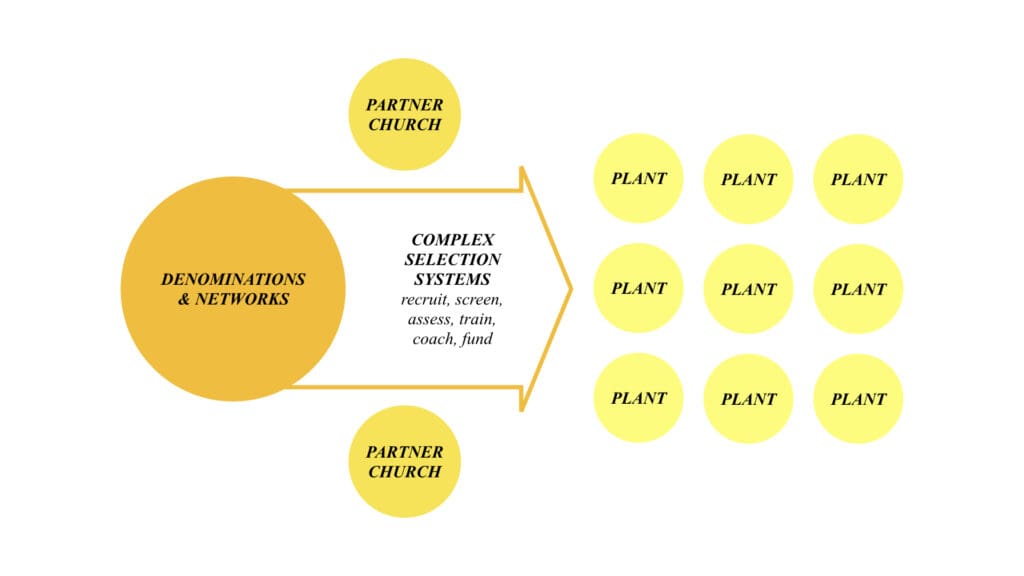The Send Institute will be releasing a full report on Best Practices in Church Planting Systems With Particular Attention to Church Planting Churches. In this report, we will share best practices in church planting systems as well as the organizational shifts necessary to see denominations and networks move beyond addition into multiplication.
As a preview to the report, we offer three basic findings from our research to describe where North American organizations are collectively in adjusting their systems to equip churches to become church planting churches.
Basic Finding #1
We are seeing significant attempts to implement church multiplication practices into church planting systems, particularly in an organization’s vision and training.
In our survey, we asked the question:
“Where does your organization use language such as (or similar to) church planting churches, church multiplication, Level 5 churches, sending churches, reproducing churches, parent churches?”
Almost half of the 130 organizations who answered have incorporated church multiplication language into either their mission or vision statements, and more than half have incorporated it into their value statements.
Mission Statement
Vision Statement
Values Statement
When asked about which competencies they provide training for, 73% of organizations indicated they provide training on church multiplication.
Provide church multiplication training
Basic Finding #2
However, the majority of organizations are reporting that few of their church plants can be categorized as actively planting other churches.
Perhaps the more significant discovery of this study is that the reality of churches planting churches has not yet caught up with the language and the idea of churches planting churches.
“What percentage of your churches can be categorized as a church planting church actively planting other churches?”
Of 130 church planting organizations, an overwhelming 74% of them indicated that less than a quarter of their churches are actively involved in planting other churches. This doesn’t necessarily indicate a negative trend. In fact, paired with some other indicators that will be released with the full report, it could just mean that the “pay-off” in church multiplication training and funding is just beginning for some organizations.
The caution here is that if a denomination or network continues to be the primary force behind planting churches, then it may never see a true multiplication movement happen because, by definition, a Church Multiplication Movement is when there is a rapid reproduction of churches planting churches.[1]
What’s important for the purpose of this report is whether or not there is a strategic emphasis on the value and equipping of church planting churches rather than just the singular focus of church planter selection.
Which brings us to the third basic finding.
Basic Finding #3
Church planting systems are still largely centered on the selection of church planters and less on the development of church planting churches.
An overall summary of our data would show that the average North American church planting organization is still highly focused on the selection of church planters. There have been encouraging finds of one specific network starting over 100 catalyst communities, which are clusters of churches that come together in a city to plant churches together. This is an example of a Church Planting System (CPS) being oriented around church planting churches, rather than just church planter selection.
Other encouraging discoveries include networks that are tracking third-generation plants and churches with church planting residents. Some networks are starting to move their churches along the spectrum of the Level 5 language developed by the Exponential organization. But the vast majority of networks still operate with varying degrees according to the basic church planter selection model.
 Again, these basic findings do not suggest that church planting organizations across North America are not on track to becoming hubs for equipping and developing church planting churches. The best of our evidence seems to show that the actual activity and practice is underway. However, the level of activity and practice has not yet caught up to the possibilities described by the theory and the language of church multiplication.
Again, these basic findings do not suggest that church planting organizations across North America are not on track to becoming hubs for equipping and developing church planting churches. The best of our evidence seems to show that the actual activity and practice is underway. However, the level of activity and practice has not yet caught up to the possibilities described by the theory and the language of church multiplication.
When that begins to happen, we believe the diagram above will look different-if not drastically, then at least substantially.
Stay tuned for the release of the full report at the end of this month. The full report includes:
- Chapter 1. What Mission Structures Reveal About Our Assumptions
- Chapter 2. Church Planting Systems
- Chapter 3. Benchmarking Data
- Chapter 4. Three Basic Findings
- Chapter 5. Eight Best Practices
- Chapter 6. Evolving Systems Intentionally Toward Multiplication
- Chapter 7. Eight Model Church Planting Churches
[1]In Viral Churches, Ed Stetzer and Warren Bird define a Church Multiplication Movement as a rapid reproduction of churches planting churches, measured by a reproduction rate of 50 percent through the third generation of churches, with new churches having 50 percent new converts. To achieve such momentum, churches would need to plant, on average, a new church every two years with each church reaching at least half of its attendees from the unchurched community.

